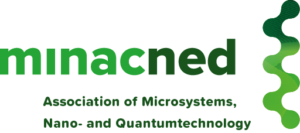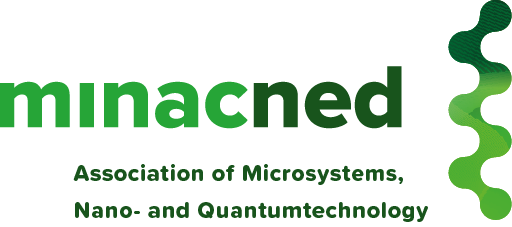Nanotechnologie heeft zich in de afgelopen decennia ontwikkeld tot een onmisbare sleuteltechnologie voor uiteenlopende toepassingen. Nederland heeft hierin, dankzij sterke programma’s zoals NanoNextNL en brede publiek-private samenwerking, een uitstekende uitgangspositie. Daarmee kan het nieuwe nationale programma ‘Nano4Society’ een vliegende start maken: het toepassen van nanotechnologie in actuele deelgebieden als gezondheid, veiligheid, duurzame energie, landbouw en voeding. Dit programma, met een beoogde omvang van ruim 400 miljoen voor de komende drie jaar, heeft op 25 september een kick-off bijeenkomst die vooruitblikt naar de komende 15 jaar nanotechnologie.
 De termijn van 15 jaar is niet toevallig. De branchevereniging van ondernemingen en instellingen in de micro- en nanotechnologie MinacNed, een van de partners in Nano4Society, bestaat 15 jaar. Bij de bedrijven in de sector van nano-gerelateerde MKB-bedrijven zijn al meer dan 5000 mensen aan het werk en dit aantal groeit hard. Dat geeft al aan dat nanotechnologie, de technologie die zich afspeelt op miljoenste millimeters, het stadium van ‘futuristische vergezichten’ is ontgroeid en nu een key enabling technology is: zonder nano waren veel producten er niet geweest en kunnen veel nieuwe ontwikkelingen niet plaatsvinden. De toppositie van Nederland is onder meer te denken aan de uitstekende infrastructuur voor zowel kennisinstellingen als de industrie, NanoLabNL. “Willen we die positie behouden en versterken, dan moeten we die voorzieningen wel op peil houden. Dat betekent: blijven investeren”, aldus prof. Guus Rijnders, voorzitter van NanoLabNL en wetenschappelijk directeur van het MESA+ Instituut van de Universiteit Twente.
De termijn van 15 jaar is niet toevallig. De branchevereniging van ondernemingen en instellingen in de micro- en nanotechnologie MinacNed, een van de partners in Nano4Society, bestaat 15 jaar. Bij de bedrijven in de sector van nano-gerelateerde MKB-bedrijven zijn al meer dan 5000 mensen aan het werk en dit aantal groeit hard. Dat geeft al aan dat nanotechnologie, de technologie die zich afspeelt op miljoenste millimeters, het stadium van ‘futuristische vergezichten’ is ontgroeid en nu een key enabling technology is: zonder nano waren veel producten er niet geweest en kunnen veel nieuwe ontwikkelingen niet plaatsvinden. De toppositie van Nederland is onder meer te denken aan de uitstekende infrastructuur voor zowel kennisinstellingen als de industrie, NanoLabNL. “Willen we die positie behouden en versterken, dan moeten we die voorzieningen wel op peil houden. Dat betekent: blijven investeren”, aldus prof. Guus Rijnders, voorzitter van NanoLabNL en wetenschappelijk directeur van het MESA+ Instituut van de Universiteit Twente.
Stroomversnelling
De onderneming van MinacNed-voorzitter Ronny van ’t Oever, Micronit Microtechnologies, is een schoolvoorbeeld. De spinoff van de Universiteit Twente bestaat al sinds het jaar 2000, telt inmiddels meer dan 100 werknemers, en is een wereldspeler op het gebied van vloeistofchips. Voor DNA-analyse,sequencing, waar ook ter wereld, wordt zelfs in 40 procent van de monsters een chip van Micronit gebruikt. Van ’t Oever: “Nanotechnologie heeft dit onderzoek echt in een stroomversnelling gebracht, door de kosten te reduceren en de processnelheid te vergroten.” Een terrein dat, ook voor een bedrijf als Micronit, daarnaast sterk in opkomst is, is ‘organ-on-a-chip’: met model-organen van levend weefsel op een chip, is bijvoorbeeld het effect van medicijnen te onderzoeken. Bijkomend voordeel van deze systemen, is dat hiermee het gebruik van proefdieren sterk teruggedrongen kan worden.
Van betere accu’s tot schoner water
Dit zijn typisch voorbeelden van ‘Nano4Health’, een van de deelgebieden waarop Nano4Society zich gaat richten. De andere drie zijn ‘Nano4Security’, ‘Nano4Sustainability’ en ‘Nano4AgroFood&Water’. Zonder nanotechnologie komen veel van deze gebieden niet verder in hun ontwikkeling. Dringend is bijvoorbeeld de vraag naar betere energieopslag dan in de huidige lithium-ion accu’s. Dringend is ook de vraag naar voldoende schoon drinkwater, of beveiliging van onze informatiesamenleving. Kennis van materialen en structuren op nano-niveau kan op al deze gebieden uitkomst bieden.
Gas geven
Dankzij het eerdere NanoNextNL-programma weten de betrokken partijen elkaar al te vinden: kennisinstellingen, TNO, grote ondernemingen en meer dan 90 MKB-bedrijven, samen met overheden. Er zijn daarnaast raakvlakken met initiatieven zoals PhotonDelta, dat de Nederlandse kracht op het gebied van fotonica bundelt. Voor Nano4Society verwachten de initiatiefnemers dat ruim 140 miljoen per jaar nodig is voor de komende jaren voor verder onderzoek en ontwikkeling. Deels is deze financiering al rond, via de partners en overheden. “Wij hebben er vertrouwen in dat Den Haag, Brussel en regionale partijen inzien dat, na de uitstekende resultaten van NanoNextNL, dit het moment is om opnieuw gas te geven”, aldus prof. Albert van den Berg (MESA+ Instituut), die tijdens de kick-off op 25 september de meerjarenprogramma’s van Nano4Society zal toelichten. Hij is, als wetenschappelijk leider van het nieuwe programma, een van de vormgevers, samen met collega’s van de betrokken universiteiten, waaronder de TU’s en het bedrijfsleven.
Meedenken
De kick-off op 25 september, bij MinacNed op locatie bij de Federatie van Technologiebranches (FHI) in Leusden, laat zien waartoe nanotechnologie in staat is. En bezoekers worden uitgedaagd om mee te denken over de koers voor de komende 15 jaar. Meer informatie en aanmelding op https://fhi.nl/minacned/agenda/1460/
Contactpersoon voor MinacNed: Nynke Minnema



